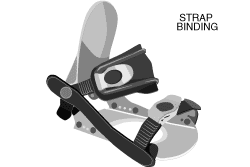Bindings
Use our guide to determine what type of bindings are appropriate for your riding style, ability, and stance.
How To Buy Snowboard Bindings
The characteristics of your snowboard binding will have a significant effect on your riding experience. Although the particular snowboard binding you choose will depend greatly on your riding style, there are also other aspects to be taken into consideration. Price and comfort should also be top on your list of priorities.
Types of bindings

Strap (soft) Bindings
- Soft bindings are the most comfortable type of bindings and are generally used by freestyles or freeride snowboarders
- They provide a good feel for the board and good flex for tricks and turns
- Soft bindings do not offer a lot of foot and ankle support and are more difficult to put on and take off than other types of bindings
- They are available with low, medium, and high backs to provide varying levels of support for your heel and Achilles tendon
Plate (hard) Bindings
- Hard bindings are not as comfortable as soft or step-in bindings, but they provide better overall support and are more similar to a ski binding
- This type of binding is used mostly by snowboard racers and those interested in doing some serious carving on the hill
- They allow you to do some tight turning, but you do lose a little of the feel for the board while gaining some lateral support

Step-in Bindings
- Step-In bindings are the simplest bindings to get in and out of
- They are good if you are just learning to snowboard because they offer good edge control and are also relatively comfortable
- Because of their convenience and ease of use, step-in bindings are becoming the fastest growing segment of the snowboard bindings market
Your Riding Stance
- There are two ways of standing on and riding a snowboard regular and goofy-foot:
- Regular riders stand with their left foot forward on the board
- Goofy-foot riders stand with their right foot forward
- To determine your style, run and slide across a hard floor. Whichever foot you put in front is the foot you should have in front while boarding.
Your Riding Style
Technical freestyle
This type of rider is most often found on the lower elevations of the mountain, hiking the halfpipe or riding in the snowboard park. Many of today's technical freestyle riders come to snowboarding with experience as a skateboarder, in-line skater, BMX, or other action sports background. While the equipment specific to this type of rider excels in park and pipe riding, it can also be very versatile across the whole mountain at less than full-speed.
- Technical freestyle bindings
- Technical freestyle bindings generally use a low hiback with 2 straps for increased flexibility and range of motion
- These bindings are not usually value/price driven
- Most technical freestyle bindings (either step-in or strap) are made of composite materials in vibrant colors
- Riders generally gain responsiveness with a minimal weight gain
Freeride
While an overused term in snowboarding, freeride is still the best way to describe the majority of snowboarders and soon-to-be snowboarders. As it suggests, freeride describes a user who intends to utilize the whole mountain. These riders enjoy everything about snowboarding: the amazing feel of carving a turn on freshly groomed slopes, the sense of flight obtained at lift-off from the big-air jump, the creativity that can only be understood descending the half-pipe, and the feel of freedom one gets floating in fresh powder.
- Freeride bindings
- Freeride bindings generally have higher hiback with 2 or 3 straps for added support and control
- These bindings come in every shape, color, and price
- For the most part, no matter what the specifics of each freeride binding, the general effect on the riding experience is minimal. This holds true for both traditional/strap bindings and Step-In bindings.
- Binding choice is commonly a packaging decision or one of brand/price/graphics
Freecarve
This type of riding style is one of the fastest growing segments within the snowboarding world. Commonly referred to as "cross-over," a majority of these riders were once skiers. A freecarve rider enjoys the full-length and width a mountain has to offer, continually transitioning from one turn to the next.
- Freecarve bindings
- As with freecarve boots, there are very few freecarve bindings
- Those that are freecarve specific can usually be distinguished by their third strap
- Step-In bindings are also available in a freecarve configuration, and are almost always manufactured from space-age composites
Alpine/Race
Alpine/Race riders are easily picked out of the crowd. They are always seen on groomed trails, laying a trench in the snow with each turn. These riders use a snowboards edge like no other rider. Using powerful body movements and gravity as their friend, alpine riders enjoy the sport only when they are connected to the snow.
- Alpine/Race bindings
- Alpine/Race bindings are usually a plate binding with hard boots
- Metal and composites are the only available materials for this type of binding